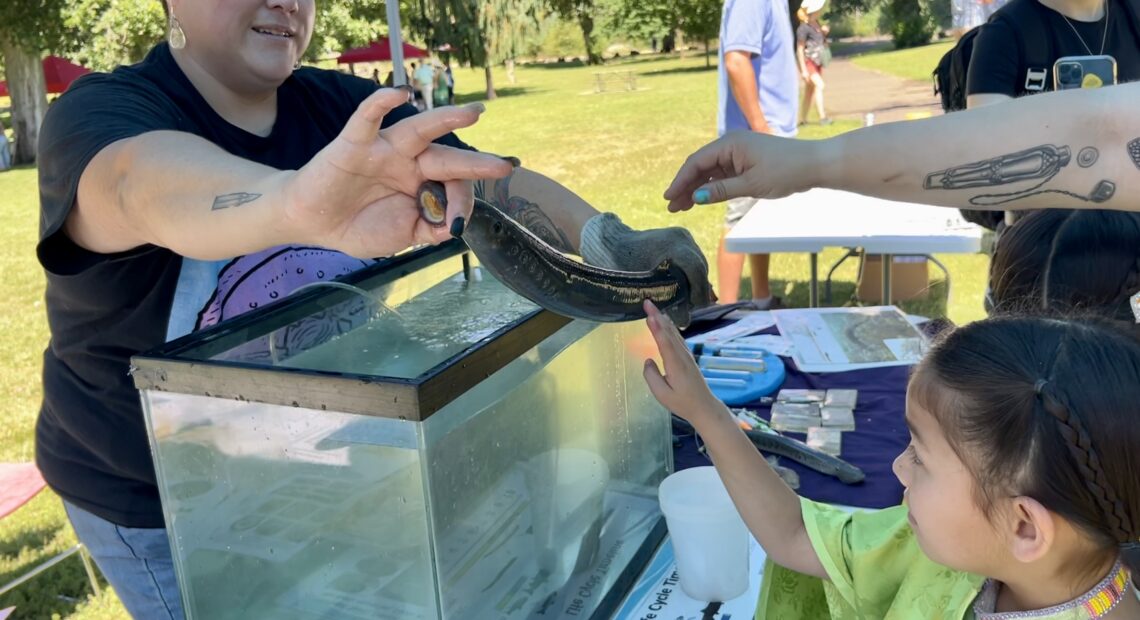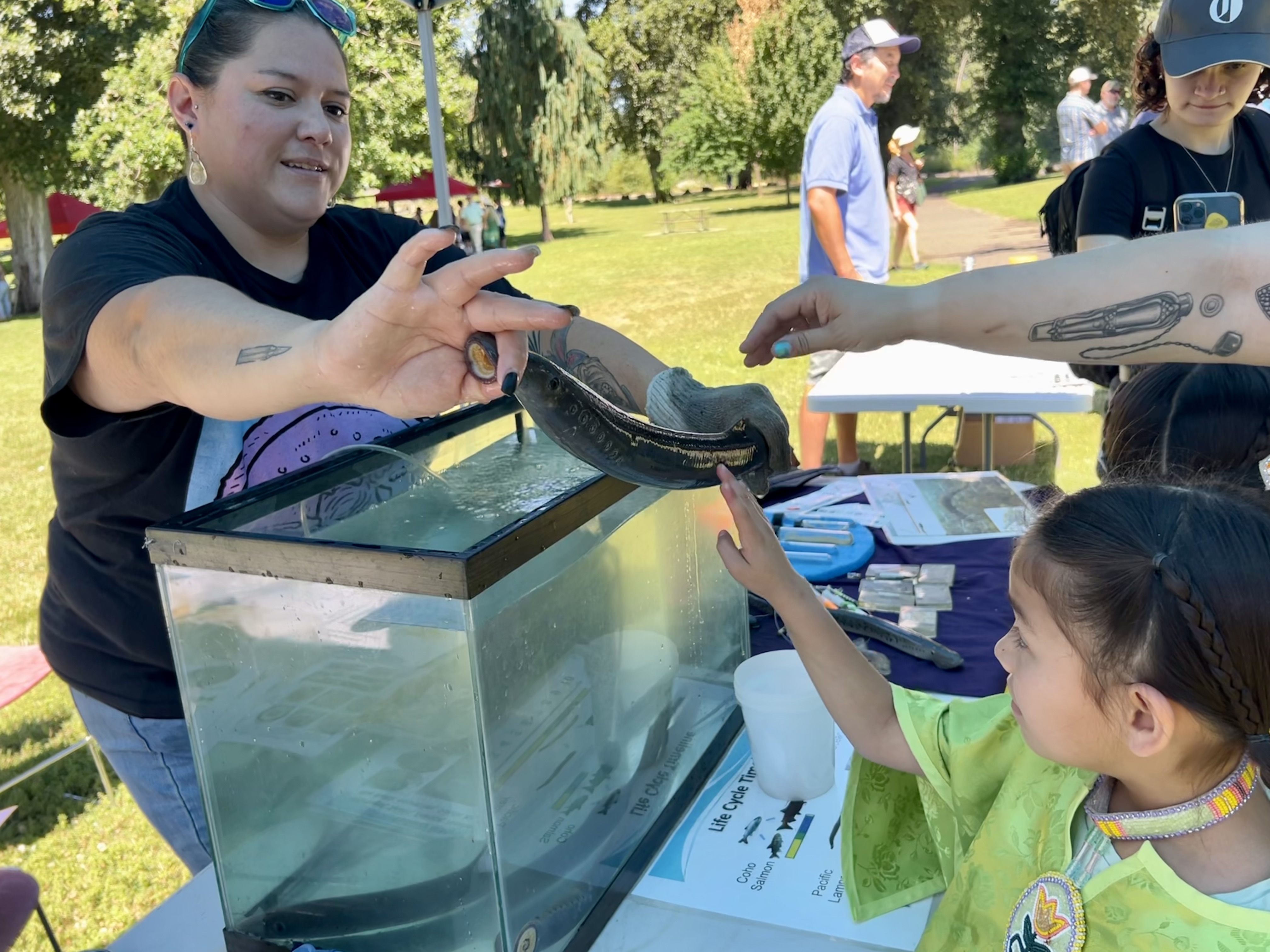
While this year’s lamprey numbers look good, tribes say more needs to be done
Listen
(Runtime 0:59)
Read
Fish counters are seeing thousands of lamprey going past the Bonneville Dam on the Columbia River. But tribal biologists say these toothy, eel-like fish have a long way to go before they’re in the clear.
With their fatty, oily meat, lamprey have served as a culturally important first food for tribes since time immemorial. However, their numbers plummeted after the dams were built.
Recently, the U.S. Army Corps of Engineers built lamprey passage structures to help the fish past several dams. A Corps spokesperson said those improvements, along with good ocean conditions, helped 63,863 adult lamprey officially migrate from the ocean as of Sept. 18. The run winds down this month.
“We are seeing about (154%) higher returns of adult lamprey than the 10-year average at Bonneville Lock and Dam,” said Tom Conning, a public affairs specialist for the U.S. Army Corps of Engineers Northwestern Division.
Those numbers were counted during the day, but lamprey are known to travel more often at night – an effort to avoid predators, biologists say. So, the Corps estimates numbers could be as high as 165,314 adult lamprey successfully migrating.
While that sounds like a lot, it is not as many lamprey as a spike of close to 300,000, or the historical numbers estimated around 1 million lamprey returning from the ocean.
“This is a step in the right direction but we can’t express enough the urgency that we need to do lamprey work,” said Aaron Jackson, a lamprey biologist and member of the Confederated Tribes of the Umatilla Indian Reservation.
For too long, he said, lamprey have played “second fiddle” to salmon.
“We’re risking losing the cultural connection of lamprey to the tribal people. Today, that’s still at even greater risk, as things aren’t progressing as fast as we’d like to see them,” he said.
The $5 million in annual funding from the Army Corps isn’t enough, he said. That has stayed the same since 2008, he said, and increasing material and construction costs has meant less can be done to recover the fish.
Ralph Lampman, a biologist and member of the Yakama Nation, said there could be creative, less costly solutions – but officials will have to pay attention to the biology of the lamprey – like an idea from California that involves using a flexible plastic tube for lamprey to suck onto to help with passage. Dam improvements are very expensive, he said.
“I feel like we need a drastic, new idea. Otherwise, the small improvements are just going to take 40, 50, 100 years to really make a big difference,” Lampman said.
He said around 50% of lamprey runs still get stuck below Bonneville Dam. That’s likely because they can’t find the lamprey passage structures or there needs to be more of them, he said.
“We want to see passage efficiency at the level that salmon experience, and we’re just a long way from that,” Lampman said.
At each dam, salmon have 90-95% passage standards, he said.
Next year, the Army Corps said it will continue building lamprey passage at Bradford Island – part of Bonneville Dam – and at The Dalles Dam.
The Corps also is conducting studies on juvenile lamprey passage downstream.
Tribal biologists are working to translocate lamprey across the Columbia Basin, Jackson said. This year, they collected the most lamprey yet, more than 11,000 fish, he said, from Bonneville, The Dalles and John Day dams.
“Mortality was really, really low during the collection. I attribute that a lot to adaptive management – how we’re collecting and holding the lamprey,” he said.
The fish are collected and brought into a large tank at Bonneville Dam, he said.
“The lamprey hang out there for a week or two and condition before they make it off to the tribes’ respective programs,” Jackson said.
In addition to those efforts, the CTUIR also releases artificially-produced offspring of those adults into the Tucannon and Walla Walla rivers, he said. The tribe releases several hundred thousand of these young fish about 30 days after they hatch.
This week, the biologists discovered 1- to 2-year-old fish where they had been releasing the larvae, he said. That means the lamprey they placed since 2021 are surviving and growing, he said. The team will use DNA to be sure those are the same fish they placed in the Tucannon River.
“We’re going to need all of those [tools] and habitat restoration,” Jackson said.
CORRECTION 10/2/23: This story is updated with misstated information from a spokesperson on the percentage of lamprey returns. As of Sept. 18, the adult lamprey migration was closer to 154% of the 10-year average.
















